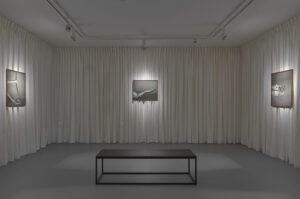
Joanna Piotrowska. Frowst, exhibition view. Photo by Jakub Certowicz
Aleksander Hudzik

Perhaps one of the most overused and detached from its original meaning is the philosophical adage that states: ‘the limits of my language are the limits of my world’. Let’s risk using this phrase to recapture its meaning in a way that its author, philosopher Ludwig Wittgenstein, wouldn’t be happy about.
Linguistic difficulties are the everyday struggle of people who live in two different worlds, like artist Joanna Piotrowska, who splits her time between England and Poland. Her works, mostly photography and video, have already been shown at the Tate Modern in London and she is now having her first major exhibition in Poland, at the Zachęta National Gallery of Art in Warsaw.
There are certain words that lose all power when translated. For example, the English word ‘vulnerability’ can be translated into Polish as słabość, which literally means weakness. These subtle differences can be found everywhere and can quite literally possess us. In Polish, boazeria could be translated to mean wooden panels or siding, but its true significance is much deeper than that.
Boazeria is an essential design feature of most Polish houses, especially those of the past decades. It’s a core element of what we call home. Some might find coziness in the repetitive rhythm of the yellowish-brown wooden panels covering cold plaster walls, or sprawled across concrete floors. But, as with any other trend, some people have taken it to the extreme, creating a horror vacui interior where there is no air to breathe and no room for escape. It is what soothes and suffocates us, this feeling which can be translated into Polish as zaduch, or colloquial British English as Frowst, the title of her show.
Boazeria is used as both a background and as a subject of many of Joanna Piotrowska’s photos presented in Frowst, at the National Gallery of Art in Warsaw. The exhibition is a survey of the artist, who was born in 1985 and studied at the Academy of Fine Arts in Cracow and Royal College of Art in London.
At the center of her photographs there is always a being, either human or animal. The very first thing we see at the Zachęta is a mosaic of black and white photography arranged like a hieratic scale, from various projects that Piotrowska has created over the years. Most of them present bodies inside an enclosed, room-like space, in peculiar relations to one another. In one there is a young adult woman sitting on the lap of an older man. Piotrowska tells me this is a father and daughter relationship. But what is most disturbing is the way that the man gazes at his child. In these works Piotrowska creatively reenacts the compositions of people who participated in psychotherapist Bert Hellinger’s Systemic Constellations therapy. This highly controversial method requires some sort of performative action. According to Wikipedia, “The person presenting the issue (seeker or client) asks people from the group to stand in the constellation as representatives. He or she arranges the representatives according to what feels right in the moment. The seeker then sits down and observes.” Piotrowska is fascinated by this performative aspect; the movements, the gazes of the still bodies are what defines her photographic style.
But the surrounding works reveal something more than just a tension between bodies. There is a certain place, a house, a domestic context for their relationship, and this context is significant. A girl, the artist’s friend, is sleeping in her childhood bedroom. Her legs dangle off the edge of the bed. The wooden railings cast their shadows across her delicate body and through this, the bed that was once safe now becomes a cage. These patterns and music-like rhythms are the pillars of Piotrowska’s work.
Shelters is her most recent project. We see adults hiding in homemade shelters built of pillows, blankets, and chairs. Like childhood forts in a living room, but are they really this innocent? These structures are also deeply reminiscent of Krzysztof Wodiczko’s Homeless Vehicles or Michael Rakowitz’ paraSITE homeless shelters. Children’s imaginary landscapes might be a real desire for people facing a crisis of shelter. This is the power of Piotrowska’s work in full view. She grabs hold of a very specific aesthetic, masterfully employing local characteristics, what we might even call an eastern European zeitgeist, to send us a much more transgressive and universal message. The therapy she re-enacts is something most of us could use, at least to a certain extent. We need shelter and we need closeness, even if it means accepting the stench of (zaduch) Frowst.
Volume 35 no 2 November / December 2020

